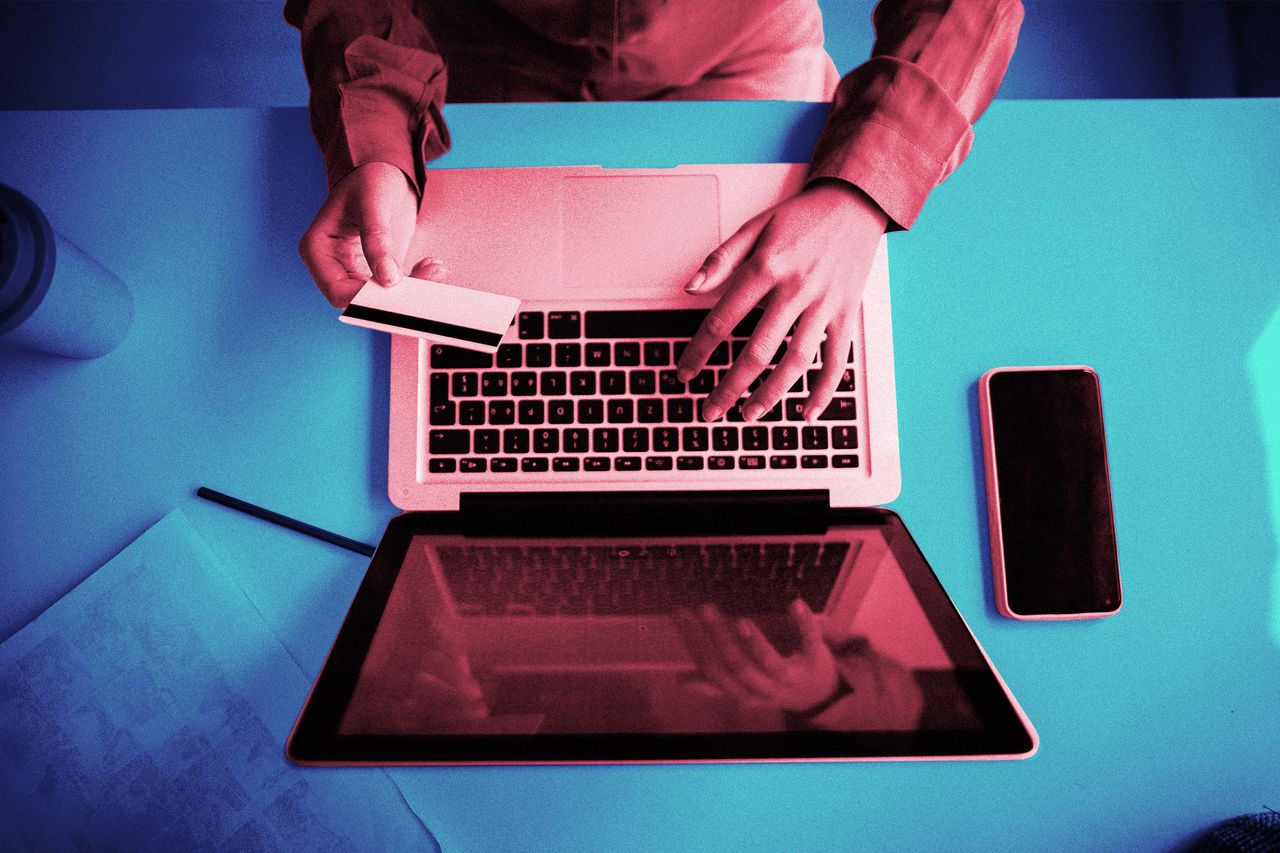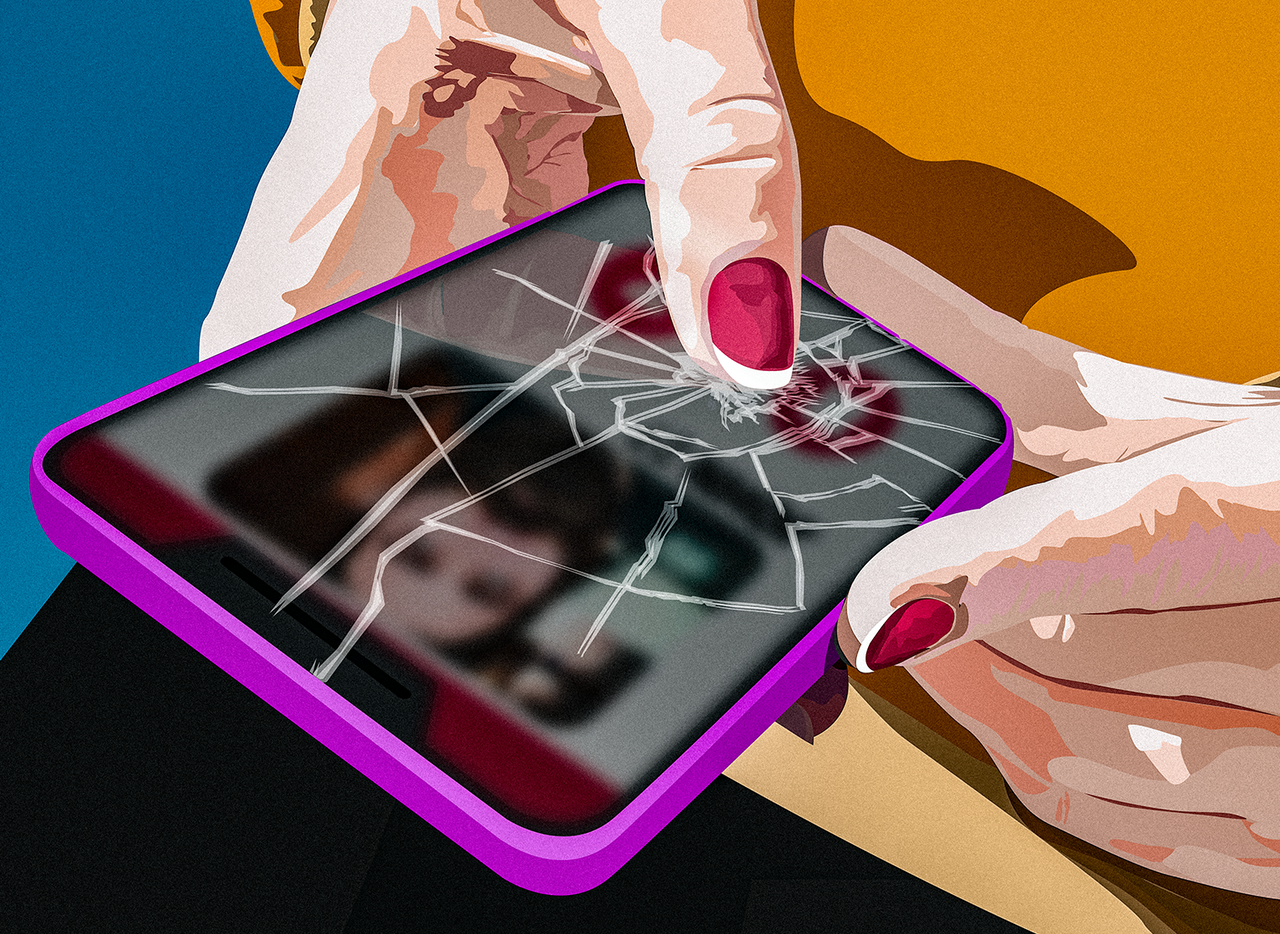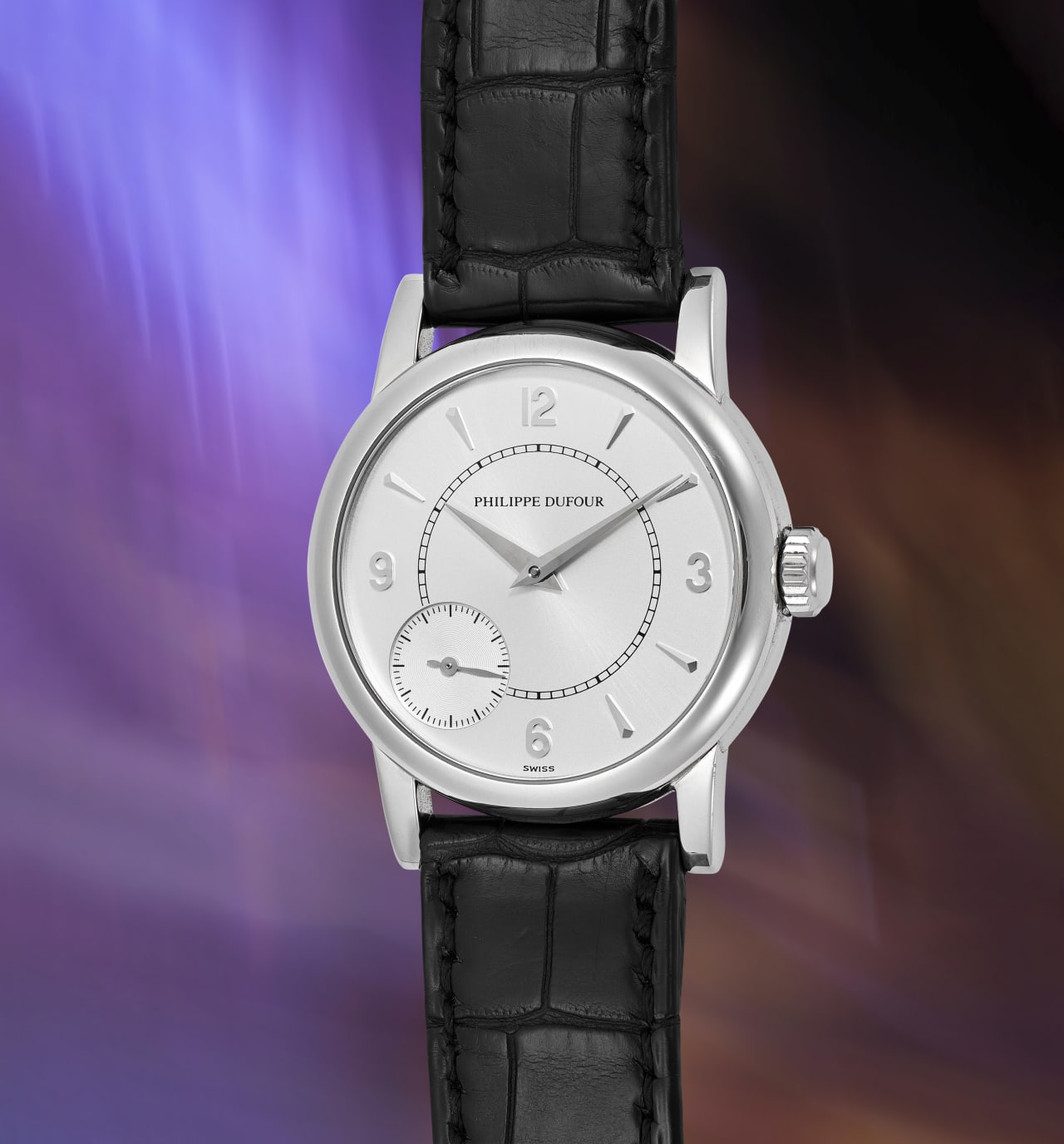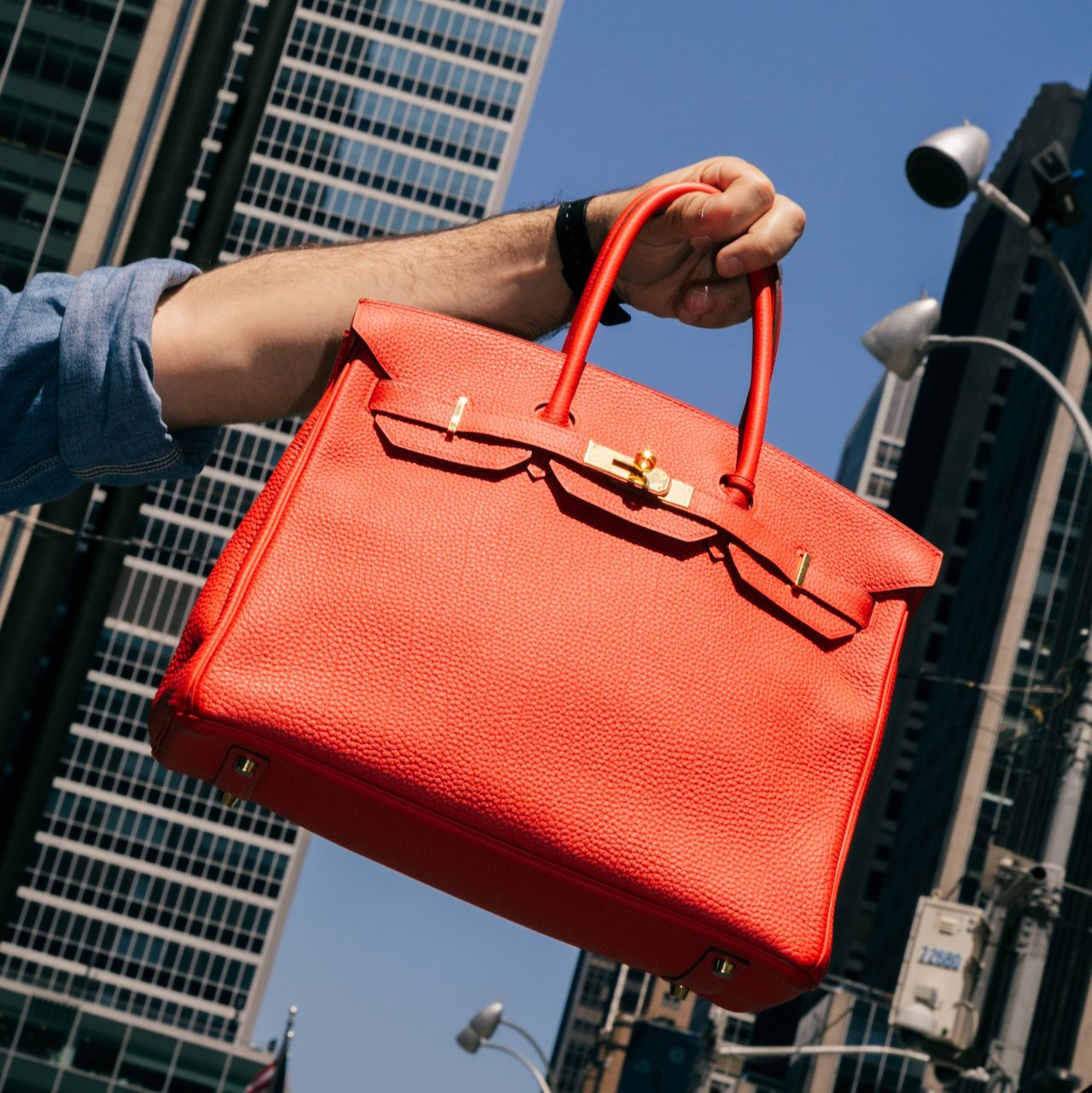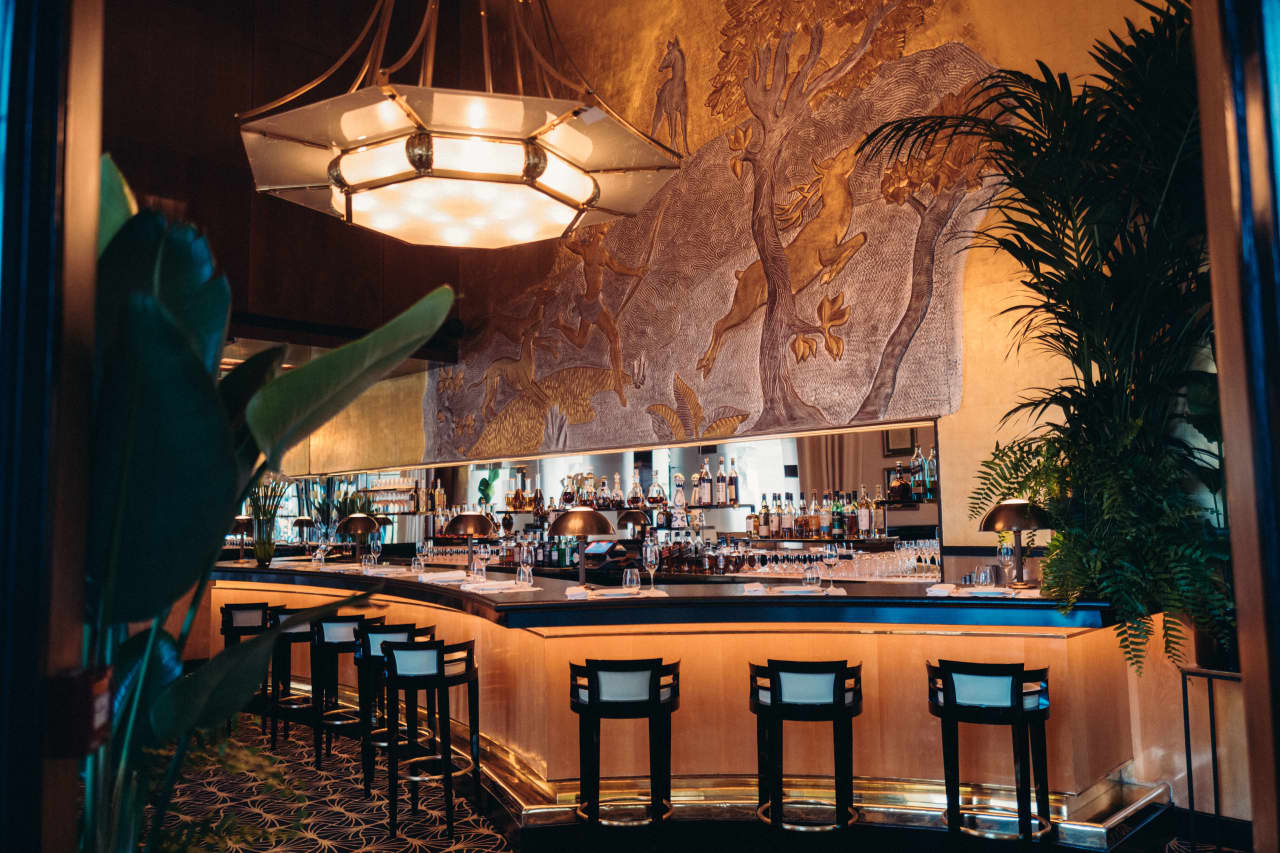Retailers Hate That You Buy Big Things on Your Laptop
People often prefer bigger screens and keyboards for pricier purchases—but merchants have more levers to pull on mobile
Shoppers want to make significant purchases on their laptops. Retailers really want them to do more on their phones.
Lately, the retailers are winning more often.
Mobile e-commerce has for years been hailed as the future of shopping . Online shops as well as airlines and hotels have upgraded and pushed apps or mobile-optimised websites as a way to get our attention—and access to our wallets. By using push notifications , mobile-only deals and other levers, vendors can tempt customers to make quick, unplanned purchases.
It’s finally working, as this past holiday season was the first time mobile-revenue share surpassed desktop, reaching 61% on Christmas Day, according to data from Adobe .
But that increase masks what shoppers say they want, particularly when it comes to large purchases. They often call these “big-screen purchases”—shopping done on computers. You might not like a retailer’s app or mobile website. You might prefer a web browser with extensions that track coupons or price changes. You might just want a second window open to check a calendar or a map.
And the laptop’s extra friction makes shoppers more careful: Many people say they have moved too fast on a phone, accidentally buying the wrong plane tickets.
As more companies amp up their mobile offerings to lure more shoppers away from their laptops, it’s good to be aware of the differences, especially if it could mean saving money.
Highflying purchase
Amanda Natividad, a 38-year-old vice president at a Los Angeles marketing startup, says she always opens her laptop before making a purchase.
She uses browser extensions to search for coupons and maximise credit-card benefits. It’s also easier for her to fill in her credit-card information with her computer in front of her and her password manager on hand, she says. And she can more easily double-check her calendar when booking flights.
“It’s just an old ingrained behaviour,” Natividad says. “It’s a flight, better use my computer for this.”
Many people tend to be on their phones while they’re distracted or in transit, but they use their computers when they’re at home or in the office, making it easier to focus, says Tim Calkins, a professor of marketing at Northwestern’s Kellogg School of Management.
“If you’re thinking about taking a vacation, early on you might be browsing through lots of different options and thinking generally about all the wonderful places you can go,” he says. “It is a very different mindset when you’re ready to spend thousands of dollars on booking the actual trip.”
Chasing convenience
Sarah Baicker, a 39-year-old content-marketing and communications manager in Washington Crossing, Pa., feels comfortable using her phone for almost every task or purchase, especially now that she’s chasing around a 2-year-old daughter. She booked a flight on the JetBlue app on New Year’s Day when she realised some credits were expiring.
“Sometimes it’s more annoying to make a purchase on a phone—that doesn’t bother me,” Baicker says. “I’m not bothered by a little bit of extra work for the sake of the convenience of not having to track down a secondary piece of technology.”
Companies have worked to make mobile purchases even easier. Services such as Apple Pay, Google Pay or Shop Pay automatically add in our billing and shipping information to our orders. If we’re shopping in an app, we’re usually already logged in and don’t have to dig up our credentials. (These are also available on laptop browsers, but they function smoothly within many mobile apps and shopping websites.)
Mobile shopping also scratches an itch for consumers who are scrolling their social-media feeds, with endless posts and stories shilling products to buy. When it comes to impulse shopping, 48% of people are likely to do so on a phone, compared with 19% on a laptop and 10% on a desktop, according to Slickdeals, a website that tracks sales and coupons.
The convenience factor seems to be working for many companies. In 2023, people shopped for flights on the United Airlines app 123 million times, a 23% increase from the year before, says a United spokeswoman. On Airbnb , 54% of total nights booked last quarter were done on the app, up from 49% booked during the same period a year ago, the company reported in its most recent quarterly earnings.
HotelTonight, which is owned by Airbnb, has long been a mobile-first company, with more than 90% of bookings happening on the app, and with some deals only available on mobile, says Ron Sandel, general manager of HotelTonight.
“At the end of the day, we’re a last-minute booking app. If you’re booking on the go—like so many of our users often are—you’re not pulling your laptop out to do that,” Sandel says.
A wider view
Though mobile shopping is becoming more popular, it still can’t make up for a bigger screen.
Logan Medeiros, a 23-year-old lifestyle and beauty content creator in Montreal, always pulls up her laptop to make a large purchase—such as her latest trip to Vancouver, Canada. The bigger screen makes it easier to open multiple tabs to compare hotels and flights.
That extra display real estate also prompts her to use her laptop for other purchases, such as buying clothes.
And more-mindful shoppers use their laptops to prevent impulse buys.
Alexander Lewis, a 31-year-old ghostwriter for tech companies and executives in Austin, Texas, set rules for himself to follow before buying anything online, such as mostly purchasing on a laptop and waiting at least a day before making the final call.
He says when he gets back to his cart, he often wonders whether he actually wants to read a book or own an article of clothing he saved.
“Having the internet always around us is an easy way to mindlessly spend our attention and also spend our money,” Lewis says.
 Copyright 2020, Dow Jones & Company, Inc. All Rights Reserved Worldwide. LEARN MORE
Copyright 2020, Dow Jones & Company, Inc. All Rights Reserved Worldwide. LEARN MORE
This stylish family home combines a classic palette and finishes with a flexible floorplan
Just 55 minutes from Sydney, make this your creative getaway located in the majestic Hawkesbury region.
Ad campaigns for online dating companies have become flashpoints for frustrated online daters
As online-dating apps court new and younger audiences, some of their marketing efforts are turning off daters instead.
Bumble last month apologised for ads making light of women so frustrated with online dating that they would consider celibacy. The League, a dating app targeting “the overly ambitious,” was called “ick-inducing” for its recent ad campaign, which included taglines like “Date someone with a 5-year-plan that makes you want to ovulate.” And Hinge’s years-long “Designed to Be Deleted” campaign has started to fall flat for longtime users still looking for love on their phones.
Online dating continues to play a lead role in the romantic lives of millions of Americans. Around half of all U.S. adults under 30 have used a dating site or app at some point in their lives, and one in 10 adults with partners say they met their significant other by dating online, according to Pew Research Center data. And the industry’s biggest players, Match Group and Bumble, now generate annual revenues north of $3.4 billion and $1.1 billion, respectively.
But the ad campaigns have high stakes for online dating companies trying to achieve the right mix of user acquisition and pricing power to re-interest Wall Street in a saturated sector.
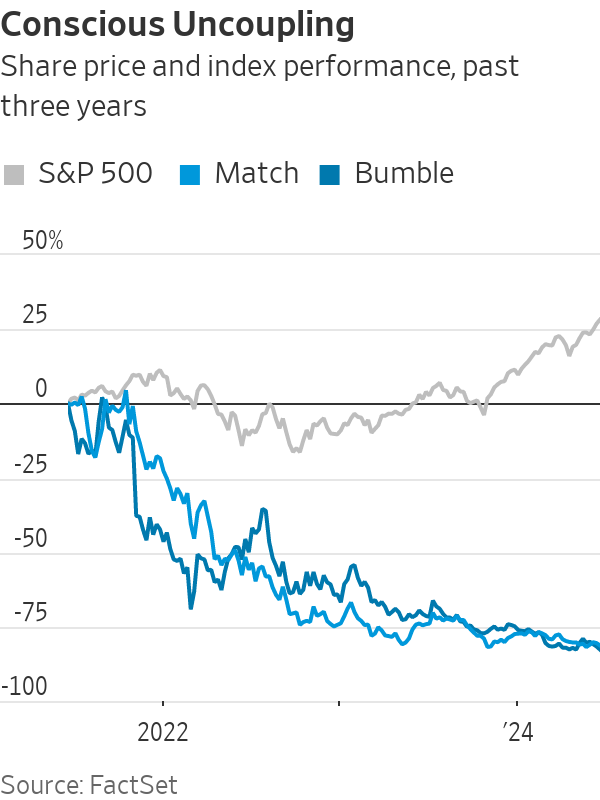
Online-dating growth has been slowing. Paying users declined 6% in the first quarter of the year at Match Group, whose portfolio includes the League, Tinder and Hinge, compared with a 3% dip in the first quarter of 2023. The Bumble app grew paying users 18% in the first quarter, compared with 31% growth in the period a year earlier.
Shares in both have fallen this year even as the S&P 500 rose. And some singles have become perhaps as wary as investors.
Nearly half of all online daters and more than half of female daters say their experiences have been negative, according to Pew , and a growing tide of users are sharing their dissatisfaction in popular Facebook forums and on TikTok. People bemoan a perceived rise in bad dating etiquette such as “ghosting” and the sending of unsolicited sexual messages, and blame the way online romance makes it easier to discard potential partners at a touch of a button. “Hacks,” or tricks designed to game the apps for better dates, abound, demonstrating the shortcomings of their designs.
And the companies’ growing emphasis on pricier premium services is giving users new reasons to scrutinise the algorithmically driven path to romance.
Bumble made its name as a free app that only let women make the first move, for example. But since 2016, it has charged for advantages such as unlimited “swipes” to connect with prospects. The most expensive plan today costs $80 a month. Nonpaying users on Bumble and other apps can hit a limit, which some say leaves them taunted by the nagging fear that their perfect partners are hidden just on the other side of a paywall.
In this environment, new ad campaigns have become a release valve for the tension.

Failure to launch
Bumble users had hoped change was on the way after a teaser campaign depicted a discouraged dater joining a convent but happily leaving after being handed the Bumble app. “We’ve changed so you don’t have to,” one of the ads promised.
“At this point, it’s the app’s responsibility not to rebrand, but to pivot technologically,” said Michelle Khouri , the founder of creator platform Recordical , who has been using dating apps on and off for 10 years following her divorce from a man she met through online dating service eHarmony.
But Bumble’s big move wasn’t a fundamental overhaul: The company was letting women put questions on their profiles to which men they matched with could respond without a specific invitation.
Disappointment became backlash when the full ad campaign included billboards that declared, “Thou shalt not give up on dating and become a nun” and “You know full well a vow of celibacy is not the answer.”
Female daters often thinly disguise their dissatisfaction with modern dating by joking about giving it up for a life of spinsterhood, and Bumble had done what all marketers try to do—joined the conversation .
The problem for many was that Bumble’s quips about nunneries located the problem in daters’ resilience, as opposed to the dating apps themselves, and the unfavourable dating culture some users say the apps’ owners have been complicit in fuelling.
“Bumble was a brand that built its identity on empowering women and then they absolutely laughed in our faces,” said Michelle Wintersteen, the founder and chief executive of branding and marketing agency MKW Creative and a former Bumble user who grew frustrated by its paywalls.
Bumble took down the billboards and made several public apologies.
“We just made a mistake in how that landed. It was not good and we felt really terrible about it,” Bumble CEO Lidiane Jones said at a Wall Street Journal event last month.
Jones added in an emailed statement that the company is enhancing its internal and external review processes, and “actively engaging in conversations to ensure our marketing tone matches the 10 years Bumble has dedicated to championing women and creating safe, respectful, and empowering spaces for connection.”
Some online-dating executives and observers think the gripes with dating apps are largely an extension of age-old ennui over the search for lasting love.
“This is not a new phenomenon, and I think that dating apps have crystallised and brought those concerns to the fore, primarily because the prior institutions that were responsible for connecting individuals—such as family, friends, churches, other homes of worship—were not able to assume blame in the same way,” said Jess Carbino, a sociologist who has worked as a consultant for Bumble and Tinder.
Pickup lines
When the League introduced its “Be a GoalDigger” brand campaign in 2023, its first big marketing effort since being acquired by Match Group in 2022, some had visceral reactions.
“Whoever is behind this truly thought they were like, hitting Gen -Z, being super edgy and cool,” said the TikTok user who reported getting the “ick” from its campaign. “In reality, it is the most millennial, cringy thing that makes you want to actually convulse.”
The app has “never been afraid of speaking up or speaking out about the kind of people that The League attracts,” said Lisa Kraynak, senior vice president of marketing for the League, in a statement. In addition to its ad mentioning ovulation, others read: “Find Your Goal Mate” and “Date Someone With Big Goal Energy.”
“We know that we aren’t for everyone, and that is a core part of our value proposition,” Kraynak added, noting that a number of people responded well to it.
Unlike apps such as Tinder and Bumble, the League requires profile approval to join. On the app, users get three to five prospects a day unless they upgrade to become a paying member, which runs $99 a week or $399 for a three-month subscription. Once a match is made in the app, users have 14 days to initiate a conversation before the matches expire.
Fighting flakes
These components, as well as features such as a “flakiness score” indicating which users have a habit of matching but not chatting, are why Kraynak said the League is “designed to combat the dissatisfaction with apps today .”
Tinder has leaned away from the celebration of singledom that it embraced in a 2018 brand campaign that called single “a terrible thing to waste.” While the app has long been associated with hookups, the company has more recently emphasised the various relationships that can result from its app. Its marketing now romanticizes “a toothbrush at their place” and “comfortable silences,” all while it seeks to upsell users.
“It was about shedding a perception that was too narrow and not accurate,” said Melissa Hobley, chief marketing officer at Tinder.
Hinge, the Match Group brand that has long positioned itself as an app for finding relationships rather than hookups, continues to iterate on its “Designed to Be Deleted” campaign launched in 2019. The company has refreshed the campaign every year since then with the same tagline.
On social media, some dissatisfied users say they have deleted the app—not because they found love but because the app didn’t work for them. Hinge said every feature is designed to help daters be intentional and that it is looking for ways to address dating burnout.
Chief Marketing Officer Jackie Jantos said Hinge is the fastest-growing major dating app.
“‘Designed to Be Deleted,’ as an idea and a marketing program, continues to help us build our base of users,” Jantos said.
Match Group said Hinge’s direct revenue grew 50% in the first quarter of the year as paying members increased 31% and revenue per payer rose 14%. It offers two types of subscriptions, Hinge+ and HingeX, which start at $14.99 and $24.99, respectively, a week.
More recently, the company partnered with a social-media brand that interviews couples on the street, to circulate their love stories that involve Hinge.
“We know that our best growth comes from organic success stories of people meeting on Hinge,” added Jantos.
This stylish family home combines a classic palette and finishes with a flexible floorplan
Just 55 minutes from Sydney, make this your creative getaway located in the majestic Hawkesbury region.









